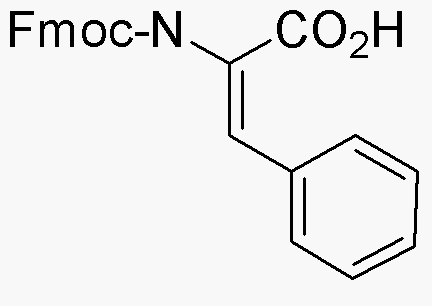Fmoc-a,b-dehydro-phenylalanine is widely utilized in research focused on:
- Peptide Synthesis: This compound serves as a key building block in the synthesis of peptides, particularly in solid-phase peptide synthesis, enhancing the efficiency and yield of desired products.
- Drug Development: It plays a crucial role in the design of peptide-based drugs, allowing researchers to create more effective therapeutic agents with improved stability and bioavailability.
- Bioconjugation: The unique properties of this compound facilitate bioconjugation processes, which are essential for developing targeted drug delivery systems and diagnostic tools.
- Research in Protein Engineering: It is used in studies aimed at modifying proteins, providing insights into protein structure and function, which is vital for understanding biological processes.
- Development of Novel Therapeutics: The compound is explored in the creation of innovative therapeutic strategies, particularly in oncology and infectious diseases, due to its ability to enhance the efficacy of treatment regimens.
Informations générales
Propriétés
Sécurité et réglementation
Applications
Fmoc-a,b-dehydro-phenylalanine is widely utilized in research focused on:
- Peptide Synthesis: This compound serves as a key building block in the synthesis of peptides, particularly in solid-phase peptide synthesis, enhancing the efficiency and yield of desired products.
- Drug Development: It plays a crucial role in the design of peptide-based drugs, allowing researchers to create more effective therapeutic agents with improved stability and bioavailability.
- Bioconjugation: The unique properties of this compound facilitate bioconjugation processes, which are essential for developing targeted drug delivery systems and diagnostic tools.
- Research in Protein Engineering: It is used in studies aimed at modifying proteins, providing insights into protein structure and function, which is vital for understanding biological processes.
- Development of Novel Therapeutics: The compound is explored in the creation of innovative therapeutic strategies, particularly in oncology and infectious diseases, due to its ability to enhance the efficacy of treatment regimens.
Documents
Fiches de données de sécurité (FDS)
La FDS fournit des informations de sécurité complètes sur la manipulation, le stockage et l’élimination du produit.
Spécifications du produit (PS)
Le PS fournit une description complète des propriétés du produit, notamment sa composition chimique, son état physique, sa pureté et les exigences de stockage. Il détaille également les plages de qualité acceptables et les applications prévues du produit.
Certificats d'analyse (COA)
Recherchez des certificats d'analyse (COA) en saisissant le numéro de lot du produit. Les numéros de lot et de lot se trouvent sur l'étiquette d'un produit, après les mots « Lot » ou « Lot de fabrication ».
Numéro de catalogue
Numéro de lot/série
Certificats d'origine (COO)
Ce certificat d'exploitation confirme le pays dans lequel le produit a été fabriqué, et détaille également les matériaux et composants utilisés et s'il est issu de sources naturelles, synthétiques ou autres sources spécifiques. Ce certificat peut être requis pour les douanes, le commerce et la conformité réglementaire.
Numéro de catalogue
Numéro de lot/série
Fiches de données de sécurité (FDS)
La FDS fournit des informations de sécurité complètes sur la manipulation, le stockage et l’élimination du produit.
DownloadSpécifications du produit (PS)
Le PS fournit une description complète des propriétés du produit, notamment sa composition chimique, son état physique, sa pureté et les exigences de stockage. Il détaille également les plages de qualité acceptables et les applications prévues du produit.
DownloadCertificats d'analyse (COA)
Recherchez des certificats d'analyse (COA) en saisissant le numéro de lot du produit. Les numéros de lot et de lot se trouvent sur l'étiquette d'un produit, après les mots « Lot » ou « Lot de fabrication ».
Numéro de catalogue
Numéro de lot/série
Certificats d'origine (COO)
Ce certificat d'exploitation confirme le pays dans lequel le produit a été fabriqué, et détaille également les matériaux et composants utilisés et s'il est issu de sources naturelles, synthétiques ou autres sources spécifiques. Ce certificat peut être requis pour les douanes, le commerce et la conformité réglementaire.


